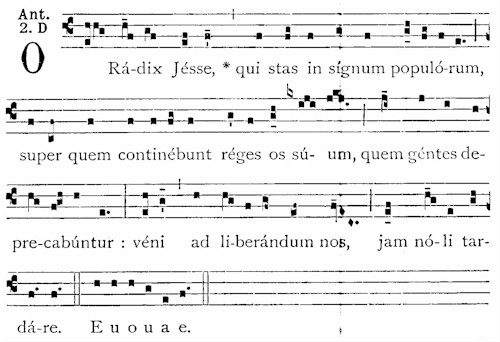
You can hear this antiphon sung in English here:
https://www.youtube.com/watch?v=O75VBNAeMQg
O Root of Jesse, standing as a sign to the people;
before whom kings shall shut their mouths,
and whom the nations shall seek:
Come and deliver us, and delay no more.
O Root of Jesse, standing as a sign to the people (Isaiah 11:10)
Before whom kings shall shut their mouths (Isaiah 52:15)
And whom the nations shall seek (Isaiah 11:10 – following the translation of the Vulgate)
Come and deliver us, and delay no more.
This antiphon is inspired by the prophet Isaiah who, in chapter 11, sings of a shoot that will
spring from the root or stock of Jesse, standing as a sign to the nations. The prophet was writing
to a people who had known calamity. Jerusalem has been destroyed. The people are in exile.
The prophet proclaims what must seem an impossible hope – that God would bring them
salvation, a victory over death and the grave. Despite the ruin of the people, cut down, pruned
and brought almost to extinction, the remaining root would flower again. It is striking that the
hope springs from the desolation, not apart or separate from it. The root or stump is a witness
both to the devastation and to the hope. Elsewhere the prophet speaks of a remnant, the
faithful few who are left. The tree may look dead, but it will blossom again.
The image is that of a Greek icon of the root of Jesse. In the icon, the entire tree is gold, from
the roots through the trunk to the branches and leaves which envelop and support twelve
figures. Jesus is a continuation of the trunk, which clearly looks like an intertwining of major
shoots from the roots, consistent with his being ‘the Vine’ as proclaimed in Greek at the top of
the icon (ἡ ἄμπελος).
With declining numbers and dwindling resources, many Christians in the West suppose that the
stump that remains is planted in impossibly arid ground. This is the ground of xenophobia, of
political extremism, of continued wars and acts of terrorism, of an endless stream of refugees
and migrants and of trafficked human beings, including children. How can it possibly flower
again? The antiphon cries out for the help that only God can give. Amidst all the signs of death
and aridity, something new is growing. This cry is grounded in the hope that as God has been
faithful in the past, so God will be faithful in the future. We need to cultivate this hope. We
need to be attentive to those places where new life is quietly growing so as to tend, water, and
cultivate it.

Recent Comments